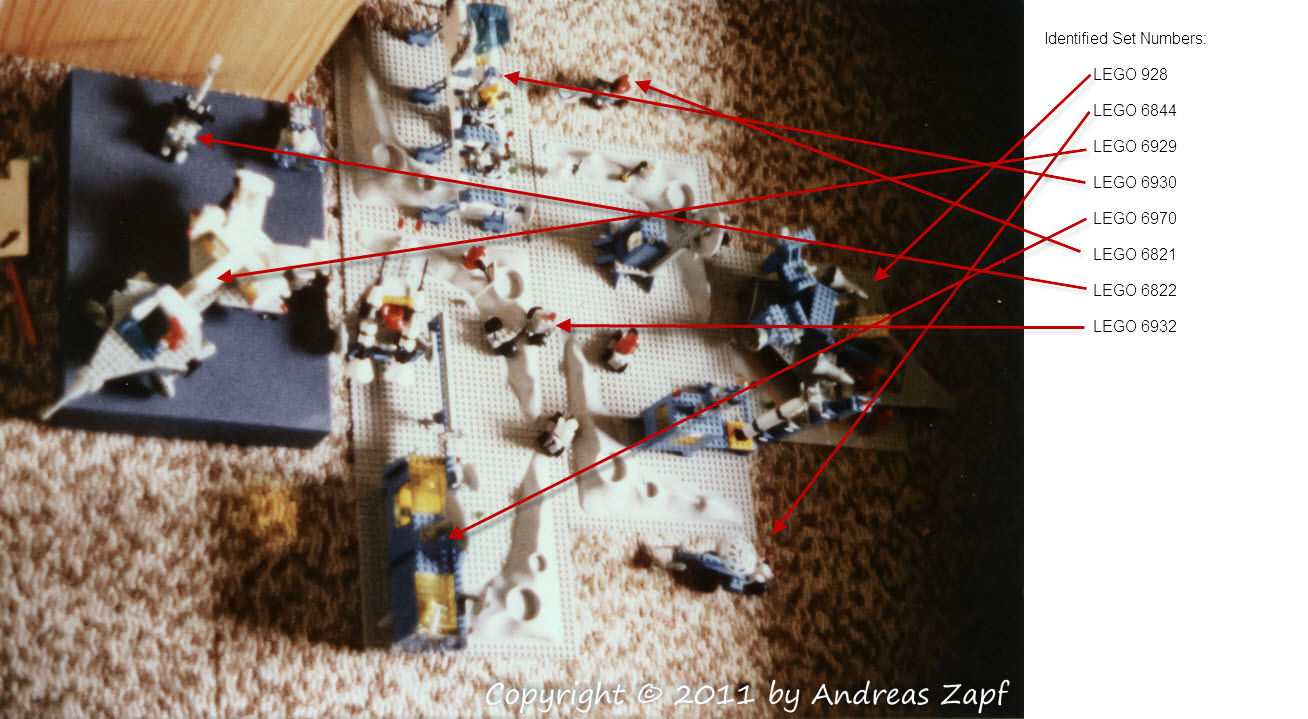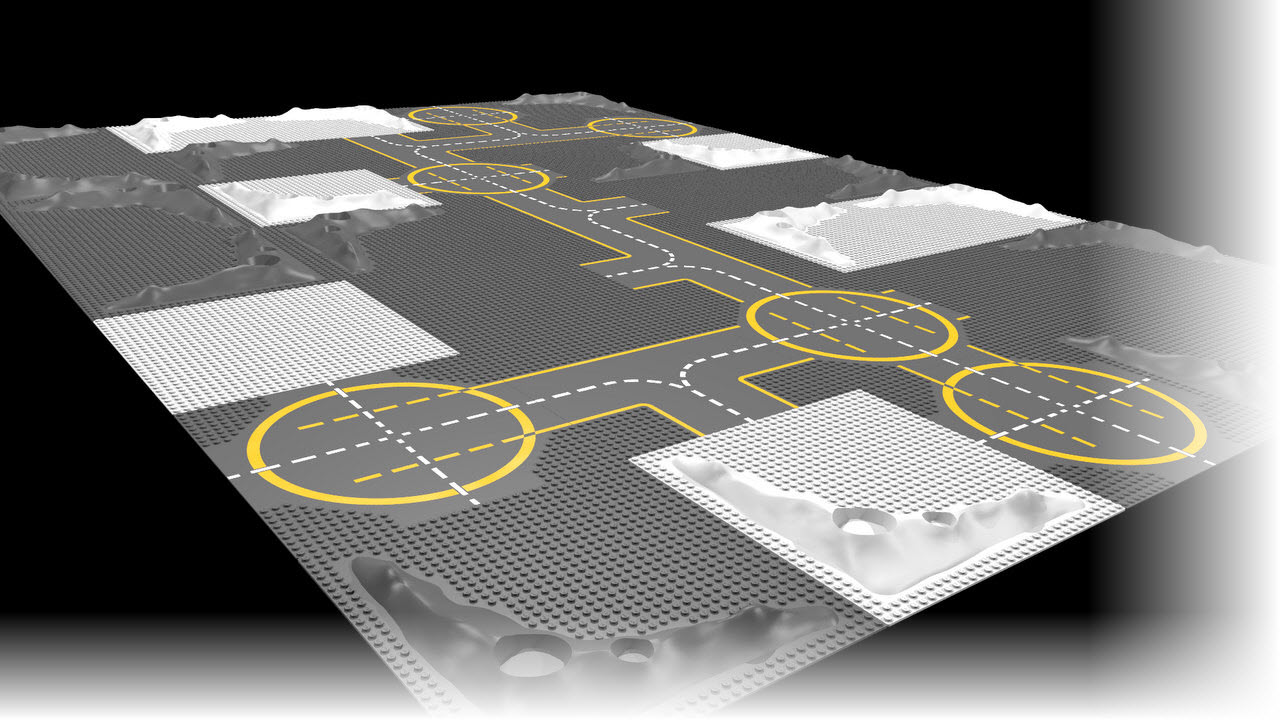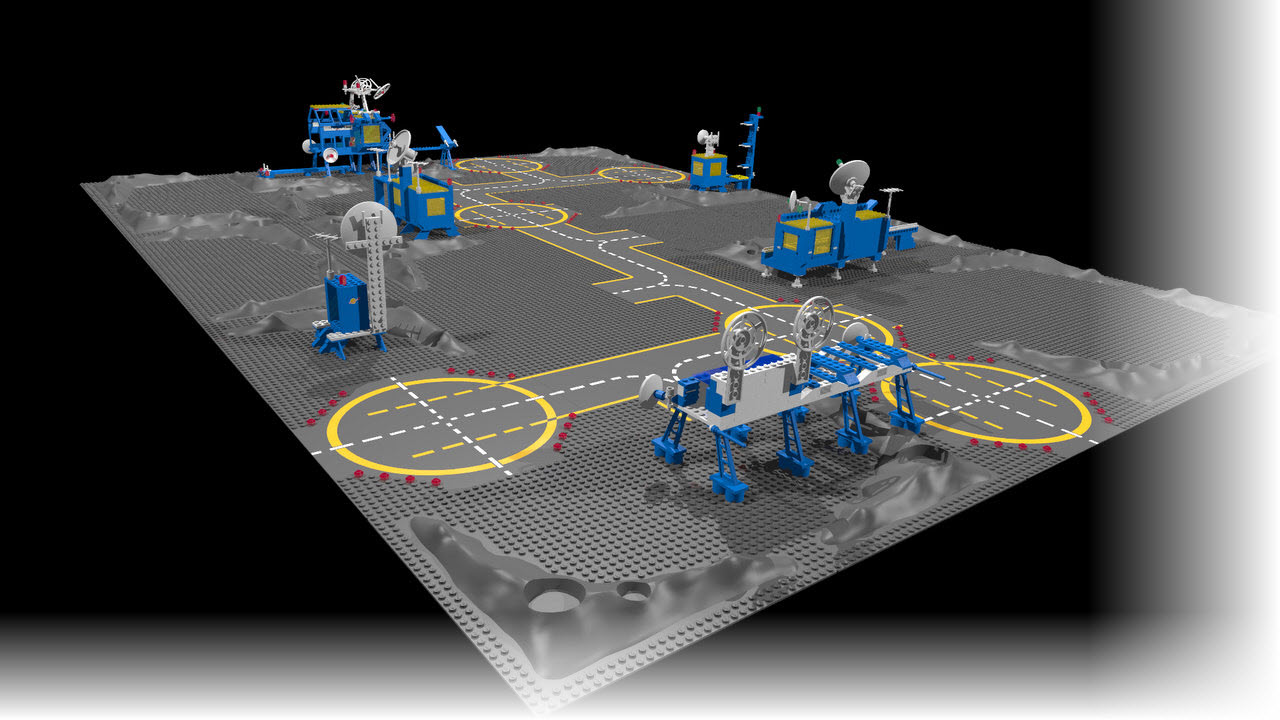An old Photo…
A little while ago, I found an old photo – must have been taken around Christmas 1983 – of a composition of LEGO Classic Space Sets. Those where the ones I once owned and played with. Unfortunately, the image is out-of-focus (those where the days where you did not have digital cameras to immediately see the results of your shots) but I was still able to identify the LEGO Sets involved.
 From left to right, you can find the following sets:
From left to right, you can find the following sets:
- LEGO 6929 Starfleet Voyager from 1981,
- just above it, LEGO 6822 Space Shuttle (eh… yes, really resembles a Space Shuttle?!?) from 1981,
- just to the right of that, an hard to identify set, most likely LEGO 6803 Space Patrol,
- then, in the lower mid-section LEGO 6970 Beta-1 Command Base from 1980,
- above it LEGO 6930 Space Supply Station from 1983.
- Next to LEGO 6970, you can see LEGO 920 Launch Pad (which was sold as LEGO 483 in the US) – released in 1979 – and finally
- LEGO 928 Galaxy Explorer (sold as LEGO 497 in the US) from 1979.
There are also three more of the smaller Sets,
- LEGO 6844 Seismologic Vehicle from 1983 and
- LEGO 6821 Shovel Buggy from 1981.
- LEGO 6923 Surface Transport (incorrectly labeled as LEGO 6932 in the image)
Some of the smaller LEGO Sets may not have made the composition for I remember having a couple of those as well – although they are not on the photo – amongst them
- LEGO 885 Space Scooter and LEGO 886 Space Buggy – classics that almost everyone had at that time (small, cheap, a nice in-between-christmas-and-birthday gifts),
- LEGO 897 Launcher (sold in the US as LEGO 462),
- LEGO 891 Two-Man Scooter,
- LEGO 6841 Mineral Detector,
- LEGO 6861 X-1 Patrol Craft,
- LEGO 6801 Rocket Sled,
- LEGO 6880 Surface Explorer,
And, of course, there had been a few of the larger LEGO Sets I never owned – two few Birthsdays & Christmas’s to gather them all (for they had not been cheap at all when it comes to the comparison of cost and available budget for a 10-year-old):
- LEGO 6950 Mobile Rocket Transport I remember I always wanted, but having been released in 1982, it is quite possible that it came too close to the end of my time playing with LEGO to actually put it on anybody’s wishlist,
- LEGO 6927 All-Terrain Vehicle was fascinating because of the large blue windows (which just had been introduced and looked pretty “futuristic” at that time),
- and LEGO 6980 Galaxy Commander which – being available in 1983 – did get in a bit late (as my focus shifted to Computers around 1984/85).
Bottom-line is that I did own quite a few of the then available LEGO Classic Space Sets – and I am truly upset not knowing where they are today (as I have once “borrowed” them to a friend and then completely forgot about them).
… and today’s Virtuality
Today, if you want to enjoy the looks of the Classic Space Sets (and not play with them) you can have that for free (and a bit of work). In my previous posts on the topic, I have shown you what software is needed and some techniques to build and render the LEGO Classic Space Sets on your monitor.
Since then, I have created most of the major Sets and some of the smaller ones using MLCad. I even did a quick & dirty Small Composition and rendered it.
Now, the time has come to put all that work together into a large Space Station Ensemble – I nick-name this one Luna 2013 as the photo in my album is labeled “Luna 13 Space Station”.
First of all, a layout of base-plates is needed which allows to position all of the desired elements. Unlike the original base plates (which have been sort of light-gray) I have chosen mine to be black (which when rendered turns into a darkish gray due to the reflection settings).
Being not limited by the supply of base-plates (which back in the 1980s was a constant problem due to cost and the space they use up!) I picked a 7 x 5 pattern – so 35 base-plates altogether.
 This is a huge scene – setting this up in reality would provide some problems due to the number of base-plates needed. The lighter ones are of the original color the base-plates had (too light for my taste when it comes to rendering) and they are the placeholders where we will add the assembled base stations later.
This is a huge scene – setting this up in reality would provide some problems due to the number of base-plates needed. The lighter ones are of the original color the base-plates had (too light for my taste when it comes to rendering) and they are the placeholders where we will add the assembled base stations later.
But first, we are going to add some red position lights around the landing pads. I am doing this for the moment to serve as placeholders – when digging a bit more into the rendering, I would like to replace those with actual lights later-on…
 Now is is the time to place the LEGO Sets – at the moment without any astronauts or vehicles. We will add those later. So starting in the “1 o’clock position” and going clock-wise, we are adding the following LEGO Sets (all created as independent MLCad Projects and merged using the Multipart -> Import Model feature):
Now is is the time to place the LEGO Sets – at the moment without any astronauts or vehicles. We will add those later. So starting in the “1 o’clock position” and going clock-wise, we are adding the following LEGO Sets (all created as independent MLCad Projects and merged using the Multipart -> Import Model feature):
- LEGO 920 Launch Pad,
- LEGO 6970 Beta-1 Command Base,
- LEGO 6930 Space Supply Station,
- LEGO 928 Galaxy Explorer,
- LEGO 926 Command Centre, and
- LEGO 6971 Intergalactic Command Base
 So this is a well-equipped Space Station in LEGO Terms – the next step will be to add some of the larger LEGO Set Space Ships (such as the LEGO 928 Galaxy Explorer Ship and the LEGO 6929 Starfleet Voyager) as well as some of the major ground vehicles (such as the LEGO 6950 Mobile Rocket Transport and LEGO 6927 All-Terrain Vehicle sets). But that will be another post…
So this is a well-equipped Space Station in LEGO Terms – the next step will be to add some of the larger LEGO Set Space Ships (such as the LEGO 928 Galaxy Explorer Ship and the LEGO 6929 Starfleet Voyager) as well as some of the major ground vehicles (such as the LEGO 6950 Mobile Rocket Transport and LEGO 6927 All-Terrain Vehicle sets). But that will be another post…
For now, just enjoy the (still life-less) scenery and the upcoming posts…
